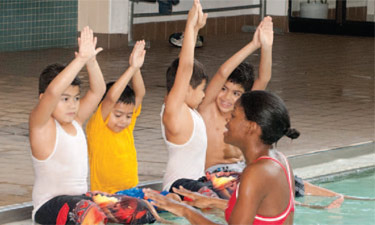 “The staff were really amazed at how fearful the children were the first day,” recalls Tara Eggleston, countywide aquatics coordinator for the Maryland - National Capital Park and Planning Commission in Prince George’s County. A group of largely Hispanic second graders had arrived at an aquatics facility for their first in-water swimming lesson. “They didn’t even want to walk down the entry to get into the pool. But by the fourth lesson, we couldn’t keep them out of the pool….It just made absolute sense to try to work with our school system, knowing that this is the community that we serve every day,” Eggleston says.
“The staff were really amazed at how fearful the children were the first day,” recalls Tara Eggleston, countywide aquatics coordinator for the Maryland - National Capital Park and Planning Commission in Prince George’s County. A group of largely Hispanic second graders had arrived at an aquatics facility for their first in-water swimming lesson. “They didn’t even want to walk down the entry to get into the pool. But by the fourth lesson, we couldn’t keep them out of the pool….It just made absolute sense to try to work with our school system, knowing that this is the community that we serve every day,” Eggleston says.
Despite well-attended learn-to-swim summer programs, minority-majority Prince George’s County needed additional water safety outreach, especially in more low income areas. Nationwide, 70 percent of African Americans and 58 percent of Hispanics report having low swimming skills, according to a 2010 University of Memphis study. So the county aquatics staff reached out to health and PE supervisors in the school system, requesting a meeting through an informational email making the connection between national swimming statistics and the population served in the county. Well-developed ties between park agency and school administrators helped foster the negotiations, and the school system provided guidance to the aquatics staff on how to develop the curriculum and lessons.
“But we had a little bit of resistance in terms of the costs for transportation,” Eggleston explains. A timely $5,000 grant from the USA Swimming Foundation finally helped overcome that obstacle. “Us obtaining that initial grant was a big push to getting this program going—it showed the schools that we were committed to finding resources to support the program and we weren’t expecting them to cover all the costs of running the program,” she says.
The curriculum included four water safety lessons at school combined with four classroom lessons at a nearby aquatics facility and four in-water lessons. Permission forms sent home to parents included a letter describing why the program was important, and only a few parents declined to give permission for their children to participate in the water portion of the program. Almost 300 second graders from five schools in the most low income and diverse areas of the county took part, of whom 88 percent said they had never had swim lessons before.
“Be persistent—don’t give up,” Eggleston advises other park agencies considering starting a school swimming program. Have a plan already in place for dealing with financial roadblocks like budget cuts, and foster long-term relationships with department heads in the schools. She credits a passionate and committed aquatics staff for putting extra work into developing a curriculum that both children and teachers felt was very valuable. “It’s definitely needed in the communities—it may not necessarily be in your community at this moment but the way demographics are changing in this country, it eventually will be your community that needs this type of program.”
Elizabeth Beard is Managing Editor of Parks & Recreation.

